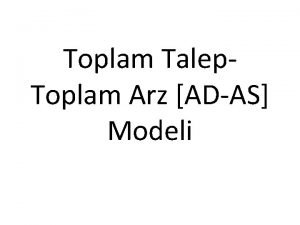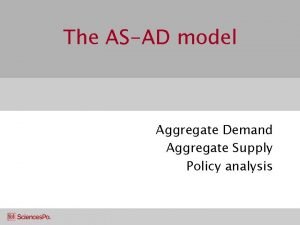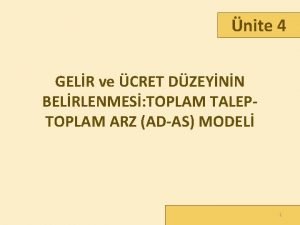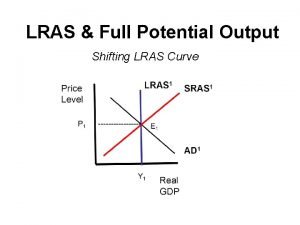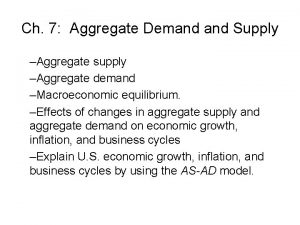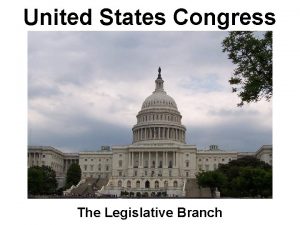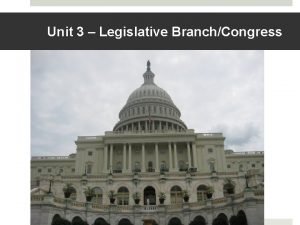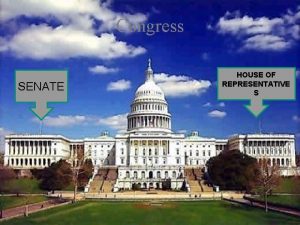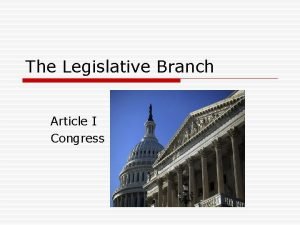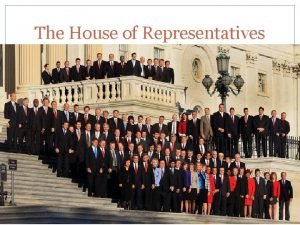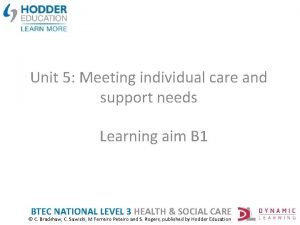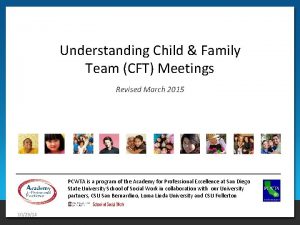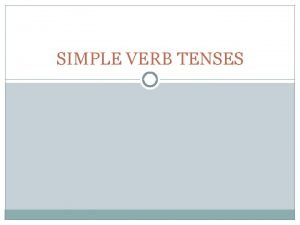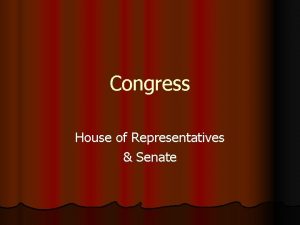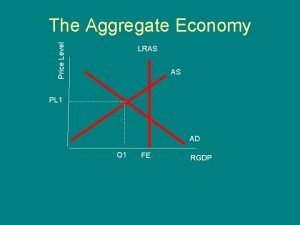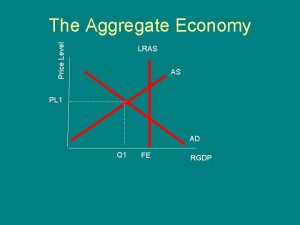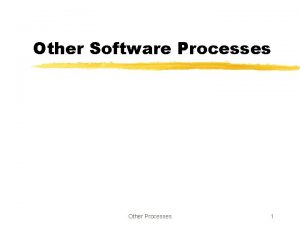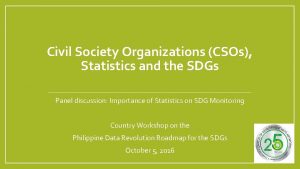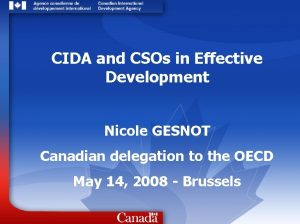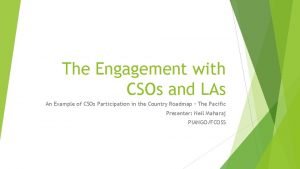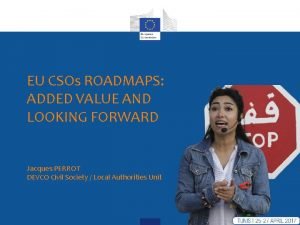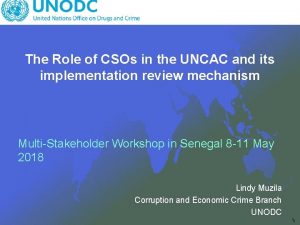Meeting with representatives of LRAs CSOs and other

























- Slides: 25

Meeting with representatives of LRAs, CSOs and other stakeholders on the EU Action Plan on the integration of third-country nationals 21 March 2016 DG HOME

Key figures on legal migration towards the EU § 20 millions third country nationals residing legally in the EU: 4% of the overall population of the EU § 2. 3 million first residence permits issued each year by Member States (2008 -2013) § Legal Migration purposes: Family (31%), Work (24%), Studies (21%), Others (23%) § 80 % of migrants in working age

TCNs in the EU: socio economic outcomes Unfavourable outcomes in terms of: § Lower employment than host-country nationals (53% vs 65%) § Even larger gaps among women and among those with tertiary education § Much larger risk of poverty and social exclusion (49% vs 23%) § Larger share of low-education (44% vs 23%) § But a rising share of tertiary educated in flows since 2008 (35% in 2009 -2014 compared to 23% in 2003 -08)

More than double increase from 2014 to 2015 in the number of (first-time) asylum applications 2011 263, 225 2012 278, 275 2013 372, 855 2014 562, 680 2015 1, 255, 640 Applications are concentrated in a limited number of MS Top countries in (first-time) asylum applications in 2015

§ 73% are men § 30% are aged less than 18 § 53% are aged 18 to 34 Distribution of first-time asylum applications by age and sex in % of total, 2015 27 M F 11 73 9 11 Less than 14 43 5 2 11 8 Y 14 -17 Y 18 -34 Y 35 -64 0 Y_GE 65 Total

§ Rising recognition rate due to origins of asylum seekers § Increasing share of refugees among the migrant population residing in the EU will represent a further key challenge for integration. § Most EU Member States will take in refugees but only a few have long standing experience in integrating specifically refugees.

Labour market integration takes more time for refugees Employment rate by immigrant categories and duration of stay in European OECD countries, 2008 Source: Based on EU-LFS 2008 module. Extracted from OECD, Is this humanitarian migration crisis different? September 2015

Gender dimension • Large gap in employment rate between host country nationals and third-country nationals • Even larger among women… • …is partly due to different reasons for migration. Main reason Total Women Men Employment 82% 79% 84% Family 49% 39% 76% International protection 41% 26% 50% Other 64% 51% 78% Study 59% 60% 59% Total 65% 53% 77% Employment rate of third-country nationals established since less than 10 years (aged 2564) by reason for migration (EU-LFS, 2008)

EU mandate on integration Focus: Integration of third-country nationals No harmonisation of legislation Art 79(4) TFEU : "… may establish measures to provide incentives and support for the action of Member States with a view to promoting the integration of thirdcountry nationals residing legally in their territories, excluding any harmonization of the laws and regulations of the Member States".

EU cooperation on integration § Common Basic Principles (2004) § European Agenda for Integration (2011) § National Contact Points on Integration § European Integration Forum (now Migration) § Inter Service Group at Commission level (2015)

EU Indicators of Immigration Integration § Common indicators in the field of employment, education, social inclusion and active citizenship § Adopted in 2010 through Council Conclusions § Following pilot study with Eurostat § Available on specific Eurostat webpage http: //ec. europa. eu/eurostat/web/migrantintegration/database § and in Joint report with OECD

EU funding § Asylum Migration and Integration Fund (AMIF) § European Social Fund (ESF) § European Regional Development Fund (ERDF) § European Agricultural Fund for Rural Development (EAFRD) § Fund for European Aid to the Most Deprived (FEAD)

Asylum, Migration and Integration Fund (AMIF) I § Global allocation for 2014 -2020: 3, 1 bln euro § Increased for 2015 and 2016 incl. the emergency assistance: 1, 53 bn euro, more needed § Scope: asylum (reception, decision-making, resettlement, capacity building), legal migration and integration (important emphasis on the local and regional level, return (encouraging voluntary returns) and solidarity (achieving a better of responsibility between MS)

Asylum, Migration and Integration Fund (AMIF) II § Biggest part of the allocation managed under shared management by MS through national programmes (all 54 approved by end 2015) § A smaller part under direct management (Union actions/open calls) where MS but also local and regional authorities and international and NGOs can apply directly, annual work programme e. g. call launched in December 2015/DD 29/02/2016 5 mill euro; integration of migrant women and access to work and integration in the work place •

Involvement of national authorities and stakeholders incl. social partners § Partnership principle § Art. 9. 1 Reg. (EU) No 516/2014; importance of consistent strategies involving the local and regional authorities to implement actions aiming at third-country nationals § Art. 12 Reg. (EU) No 514/2014 § Monitoring of the partnership framework (AIRs)

§ Available funding should be used timely and in a coordinated way: complementarity, synergies, efficiency and effectiveness with targeted actions, flexibility and experienced based approach § Relevant actors should be involved in all stages: planning, implementation, evaluation § Coordinated actions to strengthen social and economic integration and cohesion § More funding is needed to use this opportunity and to guarantee safe, open and solidary Europe

EU Action Plan on integration of TCNs § Time for the EU to step up its support to MS § The actions relate to different policy areas, reflecting cross-cutting nature of integration policies § Added value at EU level § Implementation through different channels: funding to national, local or regional authorities or civil society organizations; exchange of knowledge; practical tools; awareness raising activities.

EU Action Plan on integration of TCNs 5 phases for integration: 1. Pre-departure stage 2. Arrival/early integration 3. Integration into education and vocational training 4. Labour market integration 5. Active participation and social inclusion

EU Action Plan on integration of TCNs § Specific objectives and concrete actions for each phase § Horizontal measures on coordination between actors, gender aspects and vulnerable groups, funding, and evidence and indicators. § Reference to Common Basic Principles on Integration § Individual and tailored approach to integration § Refugee-specific set of actions

1. Pre-departure measures Equipping migrants with the skills and knowledge to succeed in the destination country (language skills, knowledge about destination country culture and values, etc. ) Supporting resettlement and relocation of refugees through pre-departure measures Prepare and support local communities

2. Arrival/Early integration measures Promoting early access to language learning and welcome classes Facilitating early skills assessment and recognition of qualifications Ensuring rapid access to labour market and vocational training Facilitating access to housing and healthcare Promoting exchanges with receiving society Supporting integration of relocated and resettled refugees

3. Integration into education and vocational training Enhancing participation to education and vocational training and improving education outcomes of migrants Supporting teachers and school staff to promote inclusive education

4. Labour Market Integration Improving labour market participation and employment outcomes for migrants, while reducing gender gaps Making full use of migrants' skills and qualifications Supporting migrants' entrepreneurship

5. Active participation and social inclusion Promoting intercultural dialogue Promoting migrants participation in political and public life Building inclusive societies Promoting migrants participation to sport and cultural activities

Horizontal objectives Coordination between key actors A refugee-specific focus Gender and vulnerable groups Future funding needs Further developing evidence and indicators
 Dell download csos for recovery
Dell download csos for recovery Toplam arz eğrisinin dikey olması
Toplam arz eğrisinin dikey olması Sras lras
Sras lras Sras eğrisi
Sras eğrisi Lras curve
Lras curve Shift in sras curve
Shift in sras curve Lras is vertical because
Lras is vertical because Monetarist lras
Monetarist lras The senate and house of representatives
The senate and house of representatives The senate and house of representatives
The senate and house of representatives The senate and house of representatives
The senate and house of representatives What is meeting and types of meeting
What is meeting and types of meeting What is meeting and types of meeting
What is meeting and types of meeting Number of representatives per state
Number of representatives per state Abcville
Abcville Congress gym
Congress gym The house of representatives chapter 10 section 2
The house of representatives chapter 10 section 2 Lesson 1 congressional membership
Lesson 1 congressional membership Importance of phylum arthropoda
Importance of phylum arthropoda For todays meeting
For todays meeting Meeting objective
Meeting objective Chapter 5 hunger games questions
Chapter 5 hunger games questions Types of position
Types of position Meeting individual care and support needs
Meeting individual care and support needs Cft meeting agenda
Cft meeting agenda Present tense of give
Present tense of give

